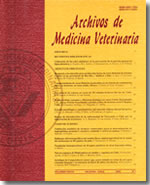Effects of 36 hours road transport with or without a resting period on live weigh and some meat quality aspects in cattle
Main Article Content
Abstract
The effects of a resting period in cattle transported by road for 36 hours, on live weight changes, carcass yield, bruising, ph and colour of the meat postmortem were determined. Data on the behaviour of the cattle during transport were also recorded.
The experiment was carried out with 40 Hereford and Angus steers and heifers produced by one farmer, of similar age, weight and fat cover. The experimental design consisted of random complete blocks according to live weight and sex, assigning 10 steers and 10 heifers to two treatment: long distance transport with (n=20) and without a resting period (n=20); the group without a resting period was transported from the farm to the slaughterhouse continuously by road for 36 hours; the other group was submitted to a resting period of 8 hours (offering water and hay ad libitum) after a journey of 24 hours and then completed 12 additional hours on the road after resting. Two lorries of similar structure were used and both groups, one in each lorry, left at the same time from the farm; a stocking density of 500 kg live weight per 1m2 was used. Descriptive statistics and analysis of variance were used to compare treatments with and without resting, and Tukey test to establish significancy of the differences, at a 5% level.
The most frequent orientations adopted by the cattle were perpendicular and parallel to the direction of the movement. Three fallen animals were found in the group without a resting period, and none in the rested animals. Both treatments had similar weight losses during transport, but animals without a rest gained 2.2 kg during resting at the slaughterhouse whilst rested animals continued losing weight (3.5 kg). Total mean losses were 10.6% in the rested and 9.6% in not rested animals (P>0.05). No differences were found in terms of hot carcass weight and proportional yield respect to initial live weight on farm. The animals without a resting period had a higher number of and more severe bruises. The mean pH was high in both groups (5.8=with; 5.8=without rest) and the colour of muscle postmortem, as measured objectively (Hunterlab) was not affected by resting (P>0.05). However, more carcasses of cattle without a rest period showed pH values higher than 6.0 (5 vs 3) and three were found to be dark cutters in the same group. It is concluded that transport of cattle by lorry for 36 hours affects negatively the quality of meat produced and that a rest stop along these journeys improves aspects such as less fallen animals, less bruising and less dark cutters, but had no effect in terms of live and carcass weight losses.

